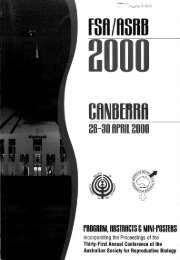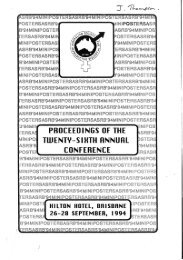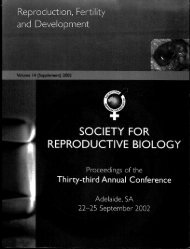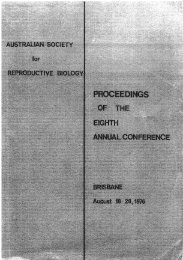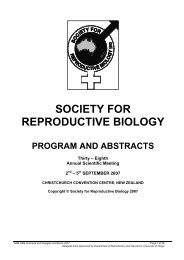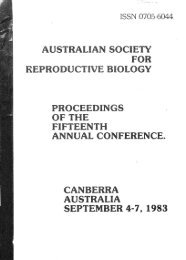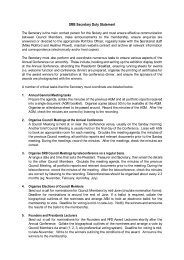N OCIETY' - the Society for Reproductive Biology
N OCIETY' - the Society for Reproductive Biology
N OCIETY' - the Society for Reproductive Biology
Create successful ePaper yourself
Turn your PDF publications into a flip-book with our unique Google optimized e-Paper software.
EXISTENCE OF EXTRACELLULAR SIGNAL-RELATED KINASE (ERK) AND p38 MITOGENACTIVATED PROTEIN KINASE (MAPK) IN THE RAT CORPUS LUTEUM (CL).M.A. Abdo, M.A. Bogoyevitch l and A.M. DharmarajanDepartment of Anatomy & Human <strong>Biology</strong>, and lDepartment ofBiochemistry,University of Western Australia, Perth, Western Australia 6907..IntroductionThe MAPK signalling cascade has· been proposed ascritical to <strong>the</strong> events of cell survival and cell death,chiefly apoptosis, in a number of biological systems.Current evidence suggests that <strong>the</strong> selective activationof MAPK family members may be important in'determining a cell's fate. MAPK activation occurs inresponse to growth factors, heat shock, and cytokines(1). Tumor necrosis factor - alpha (TNFa) is acytokine that has been shown to activate both <strong>the</strong>apoptotic (p38 and c-JUN NH2-terminal protein kinase(JNK)), and anti-apoptotic (ERK) MAPK pathways indifferent cell systems (2). As reported previously,TNFa has been implicated in <strong>the</strong> induction ofapoptosis within <strong>the</strong> CL (3). Although <strong>the</strong>mechanisms of signal transduction in TNFa-mediatedapoptosis are largely unknown. Thus our aim in thispresent study was to determine whe<strong>the</strong>r MAP Kinases(p38, JNK, ERK) are present in <strong>the</strong> rat CL and whe<strong>the</strong>rchanges in <strong>the</strong>ir expression correlate with <strong>the</strong> onset ofspontaneous apoptosis and TNFa-induced apoptosis.Materials & MethodsTotal protein and DNA was isolated from pregnant rat(Day 16, Wistar) CL cultured under two experimentalconditions. CL were ei<strong>the</strong>r incubated without trophicsupport <strong>for</strong> up to 8h in minimal essential medium(MEM: Gibco BRL) to induce spontaneous apoptosis,or 6h in MEM supplemented with 30% fetal bovineserum (FBS: Trace Biosciences) and increasingconcentrations of recombinant rat TNFa (Genzyme).Proteins were resolved by SDS-PAGE and transferredto nitrocellulose membrane (0.45Ilm). Membraneswere <strong>the</strong>n incubated with <strong>the</strong> primary antibodies <strong>for</strong>ERKI (Santa Cruz) and ERK2 (Santa Cruz)simultaneously, JNKI (Santa Cruz), or p38 (SantaCruz) diluted 1:1000 <strong>for</strong> Ih at room temperature. Thiswas followed by incubation with sheep anti-goat IgGsecondary antibody (Sanofi Diagnostics) <strong>for</strong> Ih atroom temperature. The reaction was visualized usingECL detection (Pierce). All washes were in Trisbuffered saline supplemented with 0.1 % Tween 20. 3'end DNA labelling was per<strong>for</strong>med as describedpreviously (4). A minimum of 3 animals was used <strong>for</strong>each experimental variable.ResultsWestern blot analysis revealed <strong>the</strong> appropriatemolecular weight bands corresponding to ERKl&2(44 & 42 kDa) and p38 MAPK (38 kDa) (Fig. 1),~nder both culture conditions. No significant changeIn <strong>the</strong> amount of protein <strong>for</strong> ei<strong>the</strong>r p38 MAPK orERKI&2 was detected in response92to a 7-fold increase in DNA fragmentation after 8hincubation (Fig. 2) or to increasing concentrations of TNFa(2-fold increase in DNA fragmentation at 125ng/mL) (Fig.3). We were unable to demonstrate <strong>the</strong> presence of JNKthrough Western blot analysis under ei<strong>the</strong>r of <strong>the</strong>experimental conditions.Time.__---AFig 2 (left)Autoradiographo C'l '



